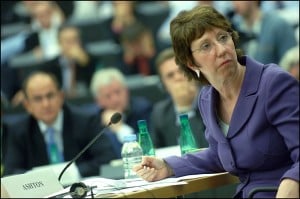 The EU’s diplomatic service, the EEAS, was from its inception placed in a difficult position. It is intended to implement policies stemming from both the nationally manned European Council and the supranational Commission. Bridging this gap has not proved an easy task, in particular at a time when the service is setting up shop, and struggling to identify its role in European diplomacy.
The EU’s diplomatic service, the EEAS, was from its inception placed in a difficult position. It is intended to implement policies stemming from both the nationally manned European Council and the supranational Commission. Bridging this gap has not proved an easy task, in particular at a time when the service is setting up shop, and struggling to identify its role in European diplomacy.
Initial reports indicate that the EEAS is not off to a flying start. Catherine Ashton has had a difficult time molding the fledgling diplomatic service, officially launched in December 2010, into a coherent whole. The reasons for this are many.
As a new organization, the EEAS has not yet cultivated an institutional culture. Although molding a common working culture will take time in any new organization, arguably the EEAS is a particularly heterogeneous entity. Its personnel has been tossed together from a variety of sources – Commission officials, Council officials, and diplomats from member states – each with their own identity and views of what role the EEAS should take on. Loyalties do not change overnight, so it is hardly a surprise that a consensus on the EEAS’ role does not exist.
Nor has a clearly defined role for the EEAS been laid out. For example, the EEAS has not been given full control of the key aspect of the EU’s Common Foreign and Security Policy; development aid. Many had initially envisioned that development – the one area where the EU’s capabilities are formidable – would be at the forefront of EEAS’ efforts. However, as a result of the turf war leading up to the creation of the EEAS, areas of development policies were surrendered to the Commission.
Ironically, the reason for this awkward division is that EU’s development aid is not allowed to be subordinate to political and economic interests. EU development funds must solely go to eradication of poverty. Although sympathetic, this line of thinking ignores that EU diplomacy and poverty eradication are not mutually exclusive.
While “double hatting” Ashton as both vice president of the Commission and Chairman of the European Council of Foreign Ministers is an important innovation, it nevertheless risks being a source of duplication between the Council and Commission. Instead of coherence, further confusion could be the result if the EEAS does not clearly define its role and mandate.
For the EEAS not to add to the cacophony that is European diplomacy, the service could take on the role as the developer and guardian of a European body of foreign policy decisions – its acquis diplomatique. By defining its role in such a manner, the EEAS would simultaneously create an identity for itself, and work for a sorely lacking consistency in European diplomacy.